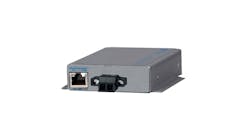To deliver Ethernet’s greater speeds, more diverse information, and other IT-aided advantages to intrinsically safe (IS) and other harsh settings, four standards development organizations (SDO) started the overall Ethernet-Advanced Physical Layer (APL) organization about five years ago. Since then, they’ve labored to develop its specification and promote its use. Consequently, they have more than a few unique insights into its inner workings and capabilities.
FieldComm Group
Even though it initially focused on intrinsic safety (IS), Ethernet-APL is a subset of the larger IEEE 802.3cg standard for Single-Pair Ethernet (SPE). This allows its capabilities and methods to serve outside of IS settings, where it’s known as Power over Dataline (PoDL) or Single-Pair over Ethernet (SPoE), which combine SPE and power on one cable, according to Sean Vincent, technical services director at the FieldComm Group. PoDL is distinguished from several Power over Ethernet (PoE) standards, which need at least two pairs of wires, require separate power, and typically operate between 54-96 Watts. This makes PoE a definite ignition and potential explosion source, prevents users from opening housings or servicing PoE devices when they’re turned on, and restricts where they can be placed.
“Large process plants have any areas where they need IS, and that’s where they can use Ethernet-APL. But they don’t always need IS everywhere, and that’s where they can use PoDL,” says Vincent. “SPE can cover everything, which is why we’re specializing in Ethernet-APL testing, conformance and registration. Conformance is an essential part of deploying Ethernet-APL and PoDL because, when users design and engineer their networks, they must know where they can connect devices, which port profiles they’ll need, what their data requirements are, and what power levels they’ll use. Even when they don’t have to be intrinsically safe, users must still be certain their network infrastructure can support them, and we can test power, data and other requirements so they can be sure.”
ODVA
“Ethernet-APL was designed to take into account lessons learned from the past. For example, it specifies shield Type A cabling along with maximum lengths in the installation guidelines to avoid isolation issues from electromagnetic interference,” says Al Beydoun, president and executive director of ODVA. “Additional concerns about security and safety have also been addressed. Like any other physical layer, Ethernet-APL transports application-layer safety and security services from the leading industrial automation standards bodies, which utilize standards such as IEC 61508 and ISA/IEC 62443. For EtherNet/IP, the CIP Security network extension is available to offer authentication of end points to ensure device trust, message integrity and authentication to ensure that data hasn’t been tampered with, confidentiality via message encryption, user-level authentication and more. EtherNet/IP also offers the CIP Safety network extension to provide fail-safe communication between nodes up to Safety Integrity Level (SIL) 3 according to IEC 61508 standards.”
Gregory Wilcox, principal applications engineer and systems architect at Rockwell Automation, adds that, “All of today’s IT-based communications with intelligent, field devices and their software require a physical-layer infrastructure to run on, and Ethernet-APL is it. Ethernet-APL brings intrinsic safety, security and other features, and the benefits of digitalization, down to those device-level components in hazardous areas.”
Beydoun reports that Proctor & Gamble has already successfully tested EtherNet/IP over Ethernet-APL.
“The assessment proved its basic installation and wiring of switches and instruments, interoperability between switches and instruments from multiple vendors, update rates and faster communications, and access to multiple variables and diagnostic variables,” adds Beydoun. “The challenges identified were focused on instrument configuration and replacement. As a result, ODVA released a specification for Process Device Profiles to provide a standard format for process variables and diagnostics across an array of devices for smoother vendor interoperability and easier DCS and PLC data integration from EtherNet/IP-enabled field devices.”
OPC Foundation
Mike Clark, director of the OPC Foundation North America, reports one of the main inspirations for Ethernet-APL is that regular, wired Ethernet is restricted to 100 meters, while two-wire Ethernet-APL can go 1,000 meters. This provides device power at 24 VDC, thus reaching smart field devices with increasing amounts of stranded data. However, to be used in IS areas, Ethernet-APL must also reduce its power to prevent potential explosions. The engineering guide for Ethernet-APL refers to three standards for how it specifies IS and how to achieve it—IEC 60079‑11, IEC 60079‑14 and IEC 60079‑25.
“The specification affirms that Ethernet-APL for use in IS areas is possible, but adds that sufficiently low-powered switches must be used to avoid transmitting enough energy to ignite potentially flammable atmospheres,” explains Clark. “Because 24 VDC typically exceeds these energy thresholds, the specification adds that Ethernet-APL must reduce voltage from the source by 40-50% to serve in IS areas, which is about 15 V, though many related devices can operate at as little as 10 VDC.”
Clark reports that his organization’s OPC UA communications framework includes protocols, encryption strategies, and platforms that are agnostic for any physical layer standard, so they can freely operate between the flat networks occupied by other Ethernet protocols and their devices. “These functions are all on OPC UA-based servers that expose participating products in the OPC UA framework, which is why suppliers want to leverage it,” says Clark. “Ethernet-APL is an Ethernet backhaul network, so if your devices implement OPC UA, then you’re in good shape. This is because users facing rip-and-replace upgrades, are looking at Ethernet-APL, which can give them one shielded, twisted-pair per device, the ability to run off a hub in a star topology out to spots in the field, and have all their application’s communications and power covered by one 24 VDC network with few added costs.”
Thanks to its long-distance, IS and accessibility attributes, Clark adds the nexus of Ethernet-APL’s appeal is that it can liberate data from increasingly intelligent field devices. “Until now, microprocessors with signals, events, alarms, and other information had to use communications that ran at what many of us lament is a snail’s pace, and there was no way to get their data due to this glacially slow throughput,” says Clark. “Traditional fieldbus topologies run at 31.24 kbps, but Ethernet-APL can run at 10 Mbps or higher. It promises a much faster data highway for controllers, historians, asset management software, maintenance software, and other functions. Ethernet-APL will facilitate IT and OT convergence, sharing data quickly over IT-like networks.”
Profibus/Profinet International
“Ethernet-APL is done,” says Michael Bowne, executive director at PI North America. “The specs are written, finalized, and published by the international standards organizations, so now is the time for more products to appear.”
To ensure they’re IS, the Ethernet-APL organization’s four SDOs are testing their data exchanges, subsystems and interfaces. Typical evaluations of each device include:
- Basic test for IS in accordance with the IEC 60079-11 standard for general use in potentially explosive environments;
- Physical layer test to check its Ethernet-APL communications; and
- Network test to ensure the device can send and receive data per the Profinet protocol’s specifications.
Bowne reports IS Profinet (Ethernet-APL) pressure, temperature, flow and level transmitters from Endress+Hauser are already available, and several are certified, while Ethernet-APL switches are available from Pepperl+Fuchs, Phoenix Contact, Softing and R. Stahl. In 2024, a dozen new products are expected to be released by ABB, E+H, Honeywell, Krohne, Samson, Siemens and VEGA, while another 16 new products are scheduled for release in 2025.
“And those are just the ones that have made their plans public. Other companies are developing Ethernet-APL products, too,” says Bowne. “In fact, back in September 2023, one switch vendor reported they’d just had their largest Ethernet-APL switch order from a mining company in Utah, even though the customer didn’t have any Ethernet-APL devices to connect yet. They did this because the ports on those Ethernet-APL switches can be configured for Profibus PA, which allows the switches to be used as proxies. This lets the mining company translate from Profibus PA to Profinet and future-proof, so they don’t need to change their wiring and switches in the future when migrating to Ethernet-APL. Its specification was written so that Fieldbus Type A cabling can be reused.”
Bowne adds that just about every major industry worldwide already uses or is moving towards Ethernet as its preferred means of communication, including in-vehicle automotive, aerospace and defense, buildings, entertainment and factory automation. “Ethernet’s physical layer comes in many flavors, each suited for a particular use-case, but now it’s ready for process control in industries that can benefit from its capabilities and familiarity, such as pharmaceuticals, oil and gas, and chemical processing,” explains Bowne. “Ethernet is immensely widespread as a communication medium, and is therefore familiar to many as a networking solution. However, appropriate hardware is required. For Ethernet-APL, these are the field switches, which are purpose-built for use with APL. Their wiring is very simple: two polarity-independent wires carrying power and communication.
“As more products are released, Ethernet-based communications stand to become the networking solution of choice for process control devices in the field. This is because choosing it is future-proof and a safe bet. APL brings the same breadth and depth of features to intrinsically safe environments that already underpin many global industries. Betting on any other networking solution besides one based on Ethernet appears risky by comparison.”





